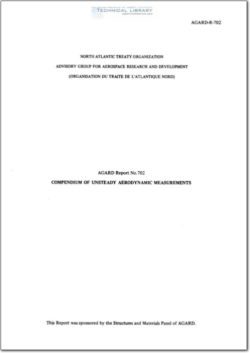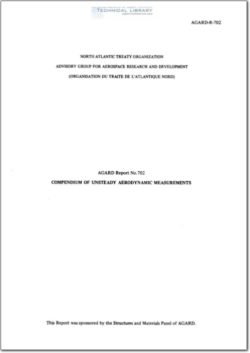AGARD-R-702

- Version
- 984 Downloads
- 5.83 MB File Size
- 1 File Count
- April 28, 2016 Create Date
- April 28, 2016 Last Updated
Compendium of Unsteady Aerodynamic Measurements

Interest in the kind of unsteady aerodynamics considered here arises from the need
for information relevant to the aeroelastic stability of aircraft. The continuing need
for studies is due to design developments extending to different types of flow and to
new structural configurations. At present there is special interest in transonic and
separated flows, in wings specially designed for supercritical flow, and in surfaces
operating as part of active control systems.
Advances in computational fluid dynamics are giving impetus to the development of
new theoretical methods for unsteady aerodynamics. The development of satisfactory
methods, whilst depending ultimately on comparisons with experiment, is considerably
helped by comparisons between one computational method and another. To assist these
develoPments a Working Group of the AGARD Structures and Materials Panel has already
chosen a series of 2—D and 3-D configurations and for each a set of test cases, including
a priority subset, to be used for comparisons. These test cases are fully identified in
Refs 0.1 and 0.2, which are the documents that have set the scene for the present
Compendium. The choaen configurations are known as the AGARD Aeroelastic Configurations
and it is now convenient to denote the chosen cases associated with them as the
Computational Test (or CT) Cases.
Although some of the configurations and some of the CT Cases were chosen purely for
theoretical interest and do not have experimental counterparts, others were chosen because
they had been, or were shortly to be, the subject of unsteady measurements. For the most
part, these measurements had been made independently by various researchers and the result-
ing data are situated at separate locations or in diverse doeuments. The present
Compendium was conceived with the idea of collecting into a single document the exPerimental
data most important for the proposed comparisons.
Whilst the prime purpose is the presentation of numerical data, it seemed desirable
to include information about the experiments themselves and to mention their more important
results. Also, when experimental data are to be used for numerical comparisons, some
indication of their reliability is needed: for this reason a general discussion of the
various experimental procedures and the limitations of experimental data is included.
For the presentation of the material, it has been found convenient to follow the
kind of arrangement already used in an AGARD document, Ref 0.3, giving a data base for
steady aerodynamics.
| File | Action |
|---|---|
| AGARD-R-702 Compendium of Unsteady Aerodynamic Measurements.pdf | Download |
Comment On This Post